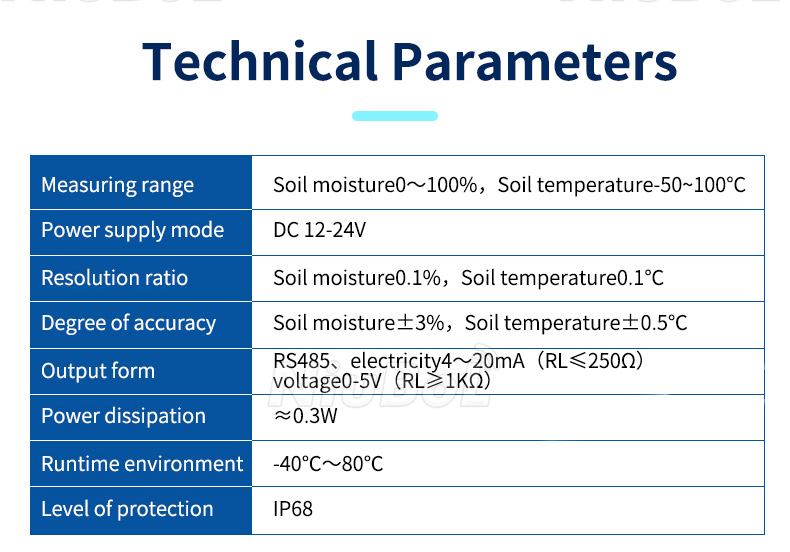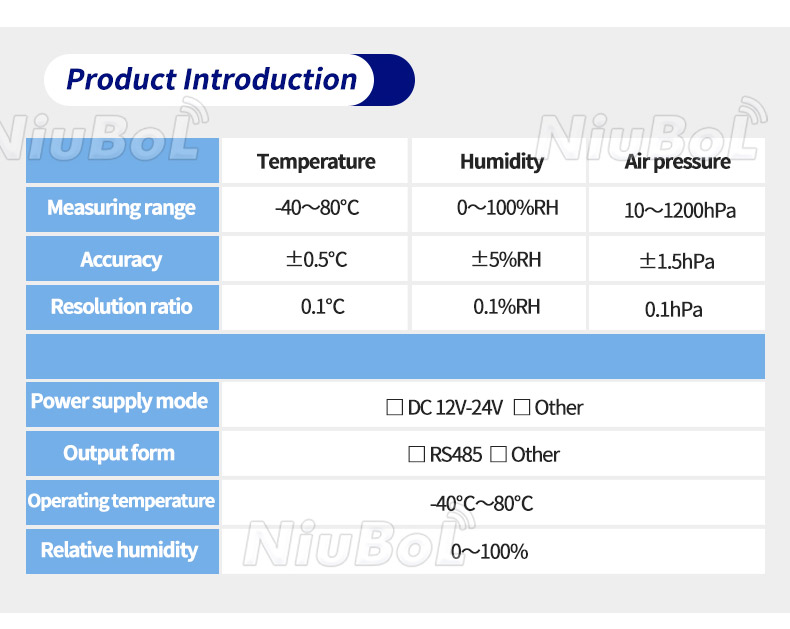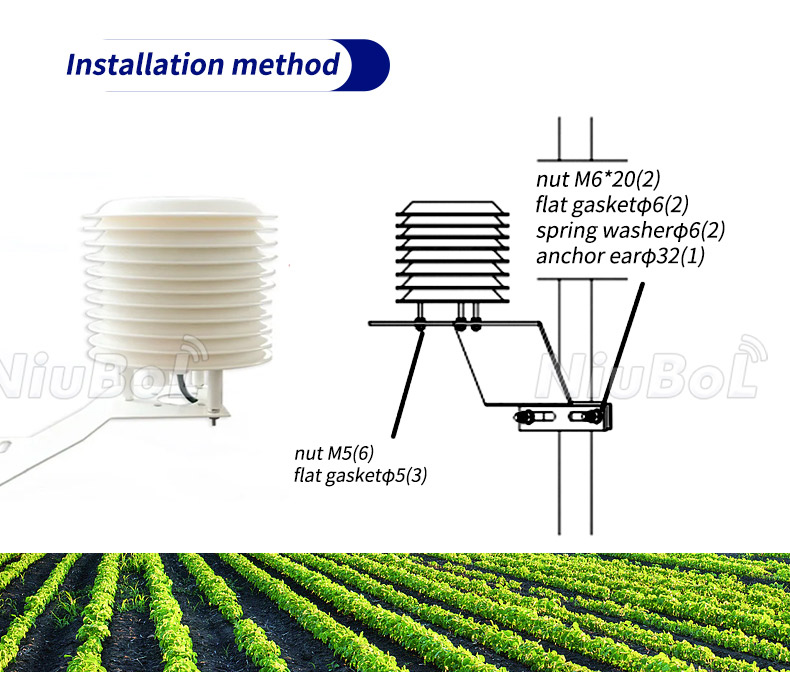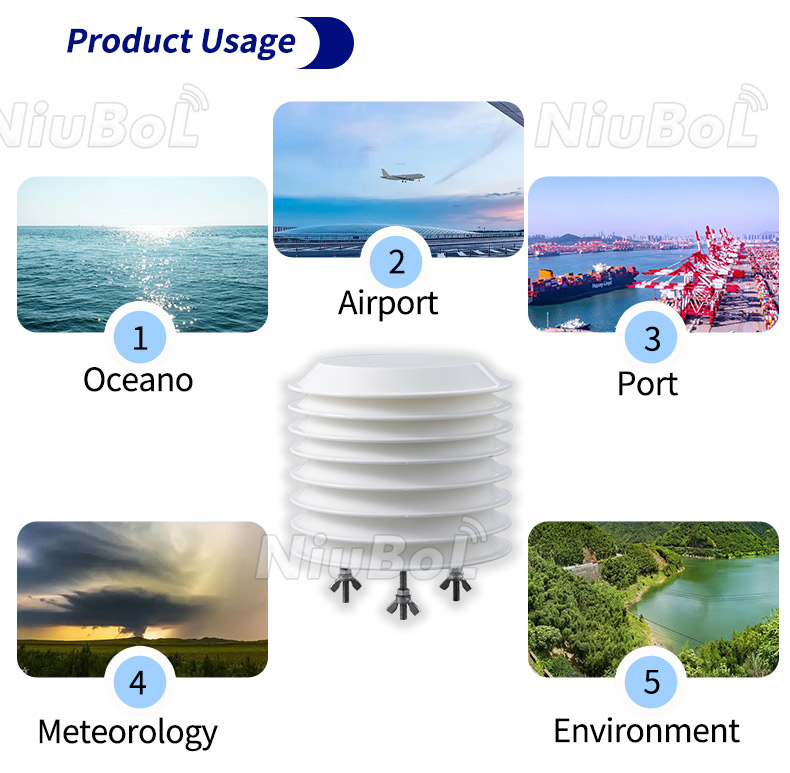

— Blogs —
—Products—
 Consumer hotline +8618073152920
Consumer hotline +8618073152920 WhatsApp:+8615367865107
Address:Room 102, District D, Houhu Industrial Park, Yuelu District, Changsha City, Hunan Province, China
Product knowledge
Time:2024-09-16 20:53:11 Popularity:2066
Soil Moisture Sensors and Relative Humidity Sensors are two different types of sensors that each play an important role in environmental monitoring, but measure different physical quantities and have different application scenarios.
Definition:
A soil moisture sensor, also known as a soil moisture sensor, soil moisture sensor, or soil water content sensor, is a device designed to measure the relative water content of soil. It is usually buried in the soil and infers the soil's water content by detecting the soil's dielectric constant or resistivity. It is widely used in agriculture, forestry, environmental protection and scientific research, etc. Especially in precision agriculture, it helps farmers to adjust the irrigation schedule according to the actual moisture content of the soil, thus saving water resources and improving crop yield.

Soil moisture sensors work on a variety of principles, mainly including the following:
FDR (Frequency Domain Reflection) principle: Using the electromagnetic pulse principle, the apparent dielectric constant of the soil is measured according to the frequency of electromagnetic wave propagation in the medium, so as to get the relative water content of the soil. This method has the advantages of simplicity and safety, rapidity and accuracy, continuous fixed point, automation, wide range and less calibration.
Resistance method: Determine the soil moisture content by measuring the resistance of the moisture in the soil. The higher the moisture content, the lower the resistance.
Capacitance method: Measure soil moisture by utilizing the property that the capacitance value of soil changes with humidity.
- Mainly used in agricultural irrigation, plant growth monitoring, soil science research, hydrogeology and other fields.
- Used to optimize irrigation schedules, monitor crop water requirements, and study soil moisture dynamics.
Definition:
A relative humidity sensor is a sensor used to measure the relative humidity in the air. It is used to measure the ratio of the amount of water vapor in the air to the amount of saturated water vapor at the same temperature, usually expressed as a percentage. It is widely used in indoor air conditioning, industry, medicine, agriculture, cultural relics protection and other fields to help users understand the degree of humidity in the air so as to regulate and control accordingly.
The working principle of the relative humidity sensor mainly utilizes the change of resistance value to measure humidity. Under the condition of a certain temperature, the higher the absolute temperature and air pressure of the air, the drier the air and the higher the resistance; on the contrary, it means that the air is humid. By detecting the voltage signal in the circuit, it is possible to determine the degree of humidity of the air in the measured environment.

- Mainly used in indoor environmental control, meteorological monitoring, industrial manufacturing, warehousing and logistics, medical equipment, laboratory research, food and beverage industry.
- It is used to regulate indoor comfort, monitor climate change, control the production environment and ensure product quality.
- In weather forecasting, relative humidity is one of the most important indicators for determining weather changes.

| Soil Moisture Sensor VS Relative Humidity Sensor | ||
| Soil Moisture Sensor | Relative humidity sensor | |
| Definition | A device that measures the relative water content of soil | A sensor that measures the relative humidity in the air |
| Principle of operation | TDR、FDR frequency domain reflection, resistance method, capacitance method, etc. | Capacitance change or resistance change is used to measure humidity. |
| Applications | Irrigation, forestry, pasture management, soil analysis, plant cultivation, scientific testing, etc. | Home, industry, meteorology, medical and many other fields. |
| Installation location | Soil moisture sensors are buried in the soil and are in direct contact with the soil medium. | Relative humidity sensors are usually installed indoors or outdoors in the air, do not need to be in direct contact with the medium, and can be sensed remotely. |
| Measurement Objects | Moisture content in the soil | Relative humidity in the air |
In summary, soil moisture sensor and relative humidity sensor in the definition, working principle, application and measurement object and so on there are obvious differences. In practical application, it is necessary to choose the appropriate sensor according to the specific needs.

Summarize
Although soil moisture sensors and relative humidity sensors are both used for humidity measurement, there are significant differences in the media they target, the principle of operation, application scenarios and measurement units. Soil moisture sensors focus on soil moisture management, while relative humidity sensors are more widely used in air humidity monitoring and control. The two differ in measurement principle, installation method, application areas, etc. Understanding these differences will help you choose the right type of sensor for your specific application to meet your specific monitoring needs.
NBL-S-THR-Soil-temperature-and-moisture-sensors-Instruction-Manual-V4.0.pdf
NBL-S-TMC-Soil-temperature-and-moisture-conductivity-sensor.pdf
NBL-W-LBTH-Atmosphere-temperature-humidity-and-pressure-sensor-instruction-manual-V4.0.pdf
NBL-W-WHT-Wall-Mounted-Temperature-Humidity-Sensors-Instruction-Manual.pdf
Related recommendations
Sensors & Weather Stations Catalog
Agriculture Sensors and Weather Stations Catalog-NiuBoL.pdf
Weather Stations Catalog-NiuBoL.pdf
Related products
 Combined air temperature and relative humidity sensor
Combined air temperature and relative humidity sensor Soil Moisture Temperature sensor for irrigation
Soil Moisture Temperature sensor for irrigation Soil pH sensor RS485 soil Testing instrument soil ph meter for agriculture
Soil pH sensor RS485 soil Testing instrument soil ph meter for agriculture Wind Speed sensor Output Modbus/RS485/Analog/0-5V/4-20mA
Wind Speed sensor Output Modbus/RS485/Analog/0-5V/4-20mA Tipping bucket rain gauge for weather monitoring auto rainfall sensor RS485/Outdoor/stainless steel
Tipping bucket rain gauge for weather monitoring auto rainfall sensor RS485/Outdoor/stainless steel Pyranometer Solar Radiation Sensor 4-20mA/RS485
Pyranometer Solar Radiation Sensor 4-20mA/RS485
Screenshot, WhatsApp to identify the QR code
WhatsApp number:+8615367865107
(Click on WhatsApp to copy and add friends)
